Some more Pinger developments which I have been working on over the winter. The whole idea being to find and recover your pride and joy when it has sunk in water you can' t see through. Sadly with model subs it is not IF but WHEN.
This work adds distance measurement.
Basic Pinger specification:
- small size (A 35mm film canister was the original idea which shows how long I have been working on this!)
- low cost (10% of the cost of the model. £30 say.)
- self powered.(Not relying on the submarine battery.)
Where we are at the moment with Pingers?
-Adequate range – about 30m in reasonably silent water.
-Ultrasonic sensors (e.g car sensor type) are quite directional so that you can “point” to the lost model. (Directionality was the major improvement in moving to ultrasonic from audio frequencies.)
-Volume is a guide to the distance from the lost model.
BUT distance measurement would be very nice to have for easy location e.g from a boat above the sunk model. In cloudy water a miss by 1 metre is a miss by a mile!
No equipment currently seems to exist which can do this at the price point we need. Some examples are:
- an underwater homing beacon used by divers. This one is about $1000.
http://www.desertstar.com/page/divetracker-scout
an ultrasonic fish finder. They are quite reasonably priced at about $100 upwards. I have never used one but I would doubt that they have the resolution to detect a model sub lying on a mud bottom. Perhaps a user could comment?
https://www.lowrance.com/lowrance/type/fishfinders-chartplotters/hook2-12-tripleshot-us-inland
Theory of distance measurement using “Time of flight.”
Sound ranging or triangulation.
The theory is well described here:
https://en.wikipedia.org/wiki/Artillery_sound_ranging
Much used by the military. You can't help thinking that if the enemy transmitted accurate time signals it would be much easier! Have a look at “on board clock."
Transponder.
The Pinger on the submarine can transmit and receive ultrasonic pulses. The search device sends an ultrasonic pulse. This is picked up by the Pinger which transmits another pulse. When this is picked up the search device the time difference is related to the distance.
On board clock.
This is the principle used in the measurement of longitude by marine chronometers and GPS satellites. You need 2 synchronised clocks one in the search device and one in the Pinger. The Pinger sends an ultrasonic pulse triggered by the on board clock. The time delay received at the search device gives you the distance.
Trials in lake at Barrow (Or what I did this winter!)
Triangulation.
The Pinger signal is picked up by 2 or 3 search devices positioned along the pond side. In practice, I used one bat detector with an underwater microphone which I moved consecutively to 3 locations with a range of about 10 to 20m. I used the 1 Hz time signal from a GPS module (NEO -7 or VK2828u7g5lf modules are very easily and cheaply available -about £6 ) as a base signal.
I displayed this on a Samsung mobile phone using an oscilloscope app (I found that“Sound Oscilloscope version 1.8 was quite good.)
But I found that it was impossible to get any consistent measurements. You are looking for faint signals only just above the noise levels in the lake. Even if you got 2 or 3 time differences you would have quite a complex calculation to get bearing and range.
I haven't done any more work on this method.
Transponder

This is quite complex in electronic terms and it needs to be physically small to fit into a Pinger. However a surface mount electronic module the HC-SR04 is very cheap (about £3) and easily available. This provides transmit and receive on one circuit board. There is also an excellent online write up on the design of the board:
http://uglyduck.vajn.icu/ep/archive/2014/01/Making_a_better_HC_SR04_Echo_Locator.html
I did some experiments on this to modify it for use as transponder. I removed the microprocessor (using a Dremel!) and fitted an Arduino Nano clone in its place.
This does work and receives and triggers ultrasonic pulses. I have only tested it in air, so far. The range isn't very good and it is a complicated system. So I have put this approach on the “back-burner.” The software is very prototype but is available here:
https://github.com/rdforrest/Pinger-model-submarine
Clock on Board.
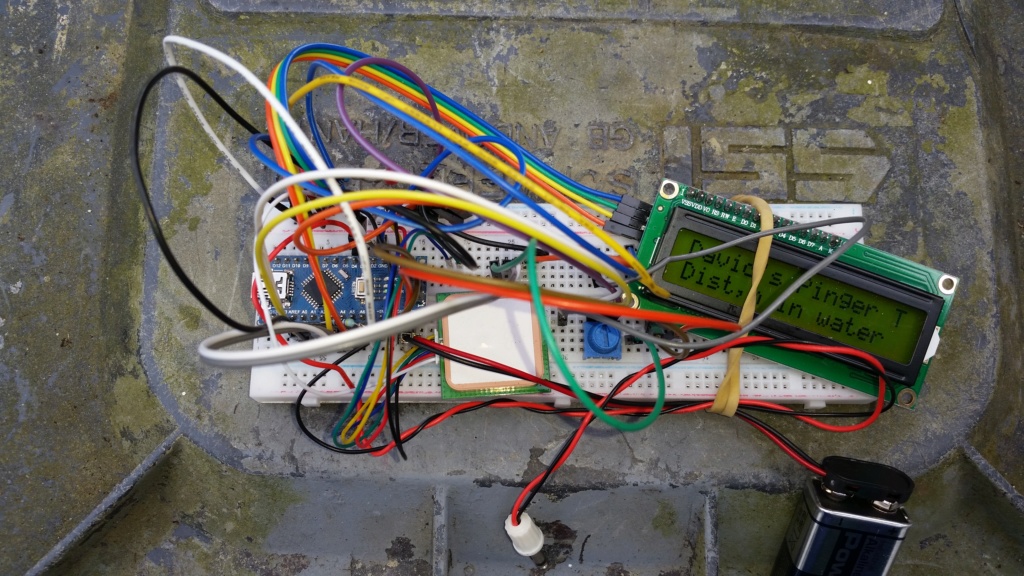
The Triangulation trials had shown what a good time base the GPS modules can be. Unfortunately they don't work underwater. Fortunately DS3231 Real Time Clock modules are available cheaply for about £3. They can provide a 1Hz time signal output and are very accurate. The velocity of sound in water (about 1500 metres per second) means that we need to be able to measure time differences of about a millisecond. They drift by a couple of milliseconds over 2 or 3 hours. (Buy several and pick a good one.)
The DS3231 module is connected to an Arduino to provide the accurately timed ultrasonic pulse. You need to set a register within the DS3231 using an Arduino sketch to get the 1 Hz output. (The details are in the software comments.)
The search device uses a bat detector as one input with the pulse from a GPS module as the other. The time delay in milliseconds and the signal strength are displayed on a 16 x 2 LCD screen. I use a 5 position DIP switch to zero the display when you synchronize the clocks. (The photos show the earlier use of a potentiometer for this purpose.) The software for
the onboard Pinger and the search device is available at:
https://github.com/rdforrest/Pinger-model-submarine
This prototype has been tested at Barrow and gives useful distance measurements over 3 to 4 m at the moment. This looks like the way to go, in my view.
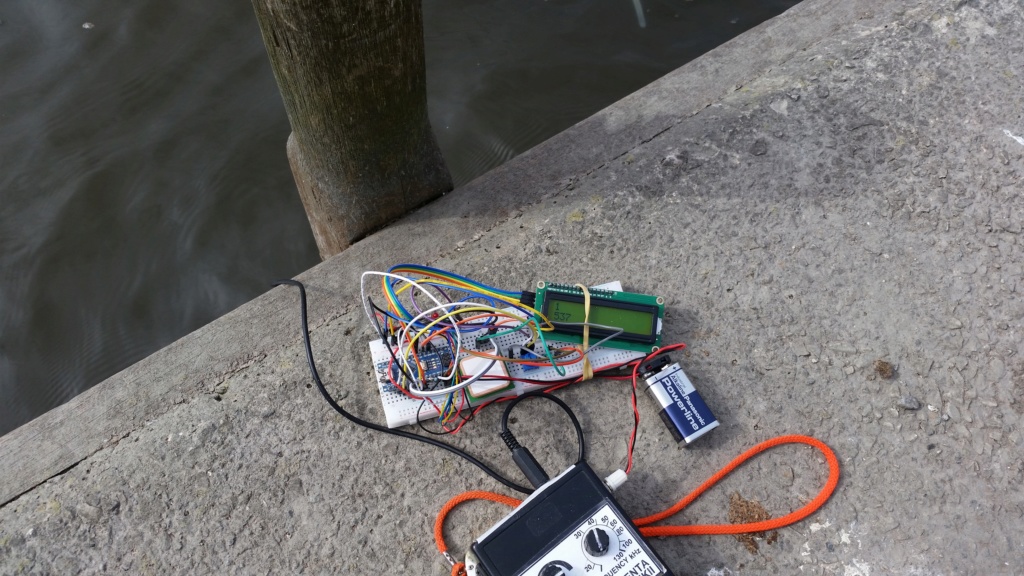
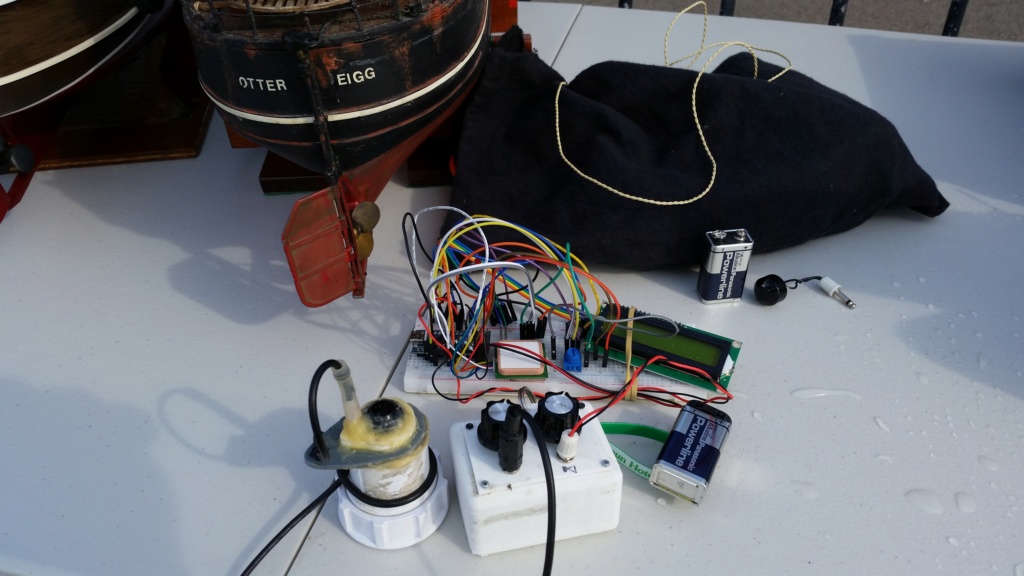

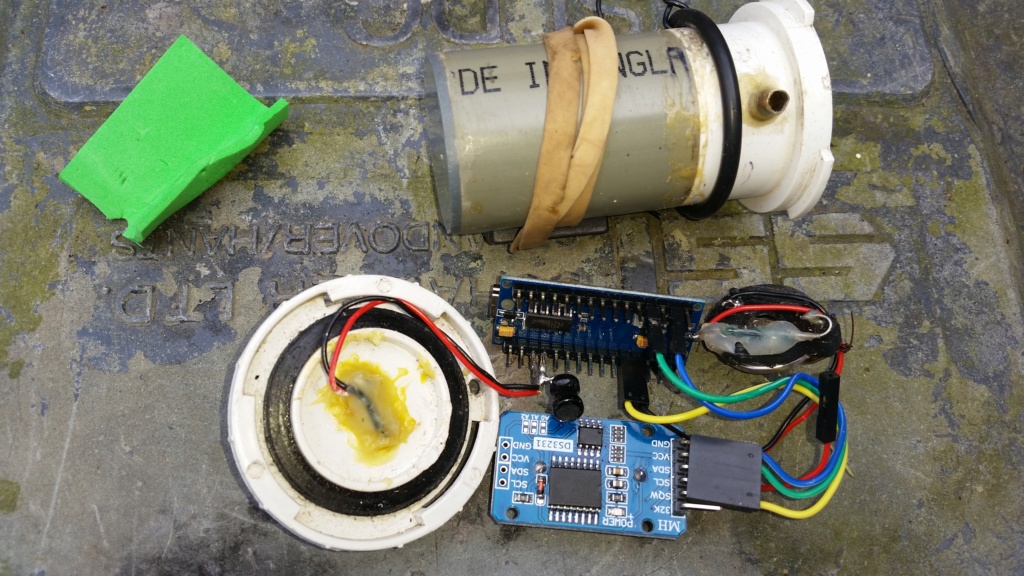
This work adds distance measurement.
Basic Pinger specification:
- small size (A 35mm film canister was the original idea which shows how long I have been working on this!)
- low cost (10% of the cost of the model. £30 say.)
- self powered.(Not relying on the submarine battery.)
Where we are at the moment with Pingers?
-Adequate range – about 30m in reasonably silent water.
-Ultrasonic sensors (e.g car sensor type) are quite directional so that you can “point” to the lost model. (Directionality was the major improvement in moving to ultrasonic from audio frequencies.)
-Volume is a guide to the distance from the lost model.
BUT distance measurement would be very nice to have for easy location e.g from a boat above the sunk model. In cloudy water a miss by 1 metre is a miss by a mile!
No equipment currently seems to exist which can do this at the price point we need. Some examples are:
- an underwater homing beacon used by divers. This one is about $1000.
http://www.desertstar.com/page/divetracker-scout
an ultrasonic fish finder. They are quite reasonably priced at about $100 upwards. I have never used one but I would doubt that they have the resolution to detect a model sub lying on a mud bottom. Perhaps a user could comment?
https://www.lowrance.com/lowrance/type/fishfinders-chartplotters/hook2-12-tripleshot-us-inland
Theory of distance measurement using “Time of flight.”
Sound ranging or triangulation.
The theory is well described here:
https://en.wikipedia.org/wiki/Artillery_sound_ranging
Much used by the military. You can't help thinking that if the enemy transmitted accurate time signals it would be much easier! Have a look at “on board clock."
Transponder.
The Pinger on the submarine can transmit and receive ultrasonic pulses. The search device sends an ultrasonic pulse. This is picked up by the Pinger which transmits another pulse. When this is picked up the search device the time difference is related to the distance.
On board clock.
This is the principle used in the measurement of longitude by marine chronometers and GPS satellites. You need 2 synchronised clocks one in the search device and one in the Pinger. The Pinger sends an ultrasonic pulse triggered by the on board clock. The time delay received at the search device gives you the distance.
Trials in lake at Barrow (Or what I did this winter!)
Triangulation.
The Pinger signal is picked up by 2 or 3 search devices positioned along the pond side. In practice, I used one bat detector with an underwater microphone which I moved consecutively to 3 locations with a range of about 10 to 20m. I used the 1 Hz time signal from a GPS module (NEO -7 or VK2828u7g5lf modules are very easily and cheaply available -about £6 ) as a base signal.
I displayed this on a Samsung mobile phone using an oscilloscope app (I found that“Sound Oscilloscope version 1.8 was quite good.)
But I found that it was impossible to get any consistent measurements. You are looking for faint signals only just above the noise levels in the lake. Even if you got 2 or 3 time differences you would have quite a complex calculation to get bearing and range.
I haven't done any more work on this method.
Transponder

This is quite complex in electronic terms and it needs to be physically small to fit into a Pinger. However a surface mount electronic module the HC-SR04 is very cheap (about £3) and easily available. This provides transmit and receive on one circuit board. There is also an excellent online write up on the design of the board:
http://uglyduck.vajn.icu/ep/archive/2014/01/Making_a_better_HC_SR04_Echo_Locator.html
I did some experiments on this to modify it for use as transponder. I removed the microprocessor (using a Dremel!) and fitted an Arduino Nano clone in its place.
This does work and receives and triggers ultrasonic pulses. I have only tested it in air, so far. The range isn't very good and it is a complicated system. So I have put this approach on the “back-burner.” The software is very prototype but is available here:
https://github.com/rdforrest/Pinger-model-submarine
Clock on Board.

The Triangulation trials had shown what a good time base the GPS modules can be. Unfortunately they don't work underwater. Fortunately DS3231 Real Time Clock modules are available cheaply for about £3. They can provide a 1Hz time signal output and are very accurate. The velocity of sound in water (about 1500 metres per second) means that we need to be able to measure time differences of about a millisecond. They drift by a couple of milliseconds over 2 or 3 hours. (Buy several and pick a good one.)
The DS3231 module is connected to an Arduino to provide the accurately timed ultrasonic pulse. You need to set a register within the DS3231 using an Arduino sketch to get the 1 Hz output. (The details are in the software comments.)
The search device uses a bat detector as one input with the pulse from a GPS module as the other. The time delay in milliseconds and the signal strength are displayed on a 16 x 2 LCD screen. I use a 5 position DIP switch to zero the display when you synchronize the clocks. (The photos show the earlier use of a potentiometer for this purpose.) The software for
the onboard Pinger and the search device is available at:
https://github.com/rdforrest/Pinger-model-submarine
This prototype has been tested at Barrow and gives useful distance measurements over 3 to 4 m at the moment. This looks like the way to go, in my view.




Last edited by david f on Thu Aug 22, 2019 8:50 am; edited 2 times in total
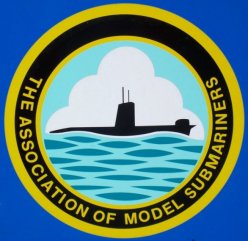



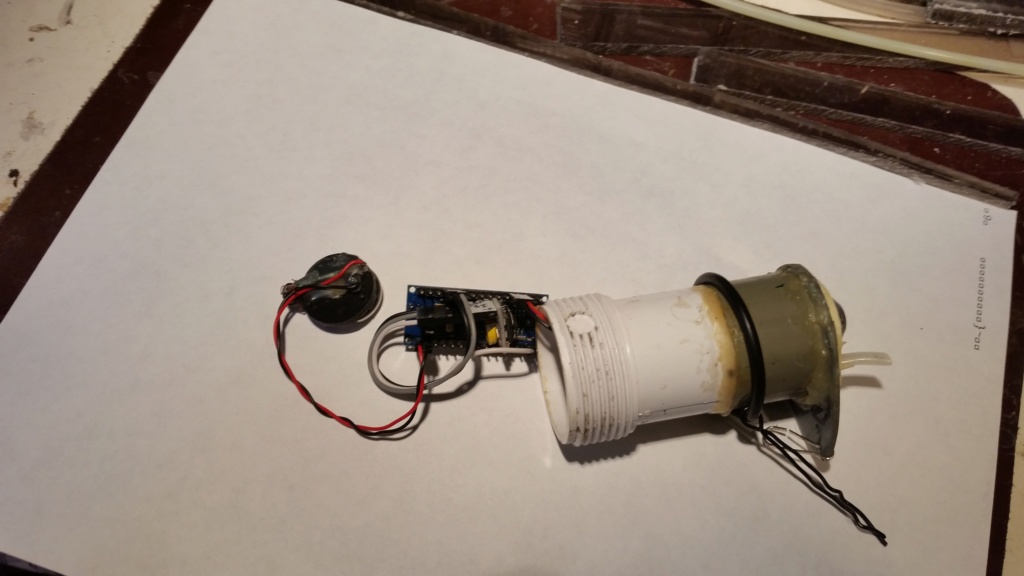


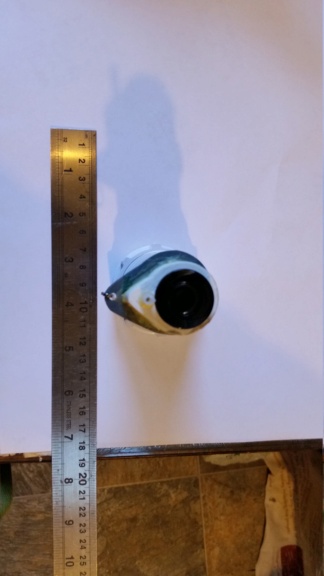
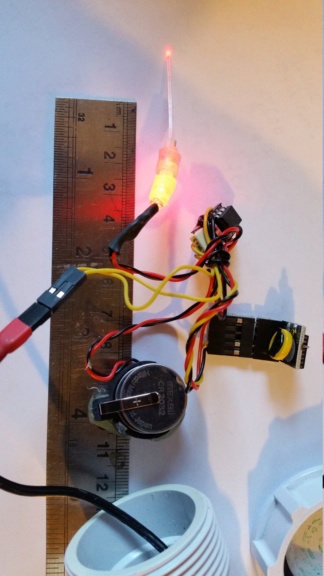

» Futaba -868/915mhz equipment
» Darnell type 21 submarine, need some help
» Robbe Seawolf V2
» bladder bags
» WW2 mini sub build
» Peral Submarine of 1888
» U-Boat R/C?
» Cheap Arduino Auto leveler